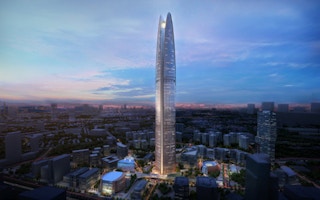1. World’s first clean energy skyscraper unveiled in Indonesia
Indonesia’s state-owned energy company Pertamina began construction on its new headquarters in January, an iconic 99-storey skyscraper located in Jakarta which aims to achieve zero net energy use, zero waste discharge, and reduced water demand. The building’s construction will include a wind tunnel, rooftop solar panels, and a central energy plant within the building.
To continue reading, subscribe to Eco‑Business.
There's something for everyone. We offer a range of subscription plans.
- Access our stories and receive our Insights Weekly newsletter with the free EB Member plan.
- Unlock unlimited access to our content and archive with EB Circle.
- Publish your content with EB Premium.
2. Architects worldwide commit to phasing out emissions in the built environment by 2050
The International Union of Architects in August unanimously adopted a declaration pledging to phase out carbon dioxide emissions in the built environment by 2050. Known as the 2050 Imperative, the declaration is signed by 15 architecture associations from all over the world, including the World Green Building Council and the Architects Regional Council Asia. Its signatories must plan and design cities and buildings to be carbon neutral, and advocate responsible architecture practices.
3. Australia and New Zealand lead in real estate sustainability
The 2014 Global Real Estate Sustainability Benchmark results released in September showed Australia and New Zealand remaining as leaders in overall performance, although Asian property companies are following closely behind.
Australia and New Zealand outperformed all other regions (North America, Europe and Asia) on all aspects measured, including on management, policy and disclosure, risks and opportunities, monitoring and EMS, among others.
Overall, sustainability reporting was improving in terms of coverage and quality, and sustainability performance was also on the rise. Regionally, the overall performance of property companies and funds in Asia increased most significantly, by 23 per cent to 46 points (out of 100), while Australia and New Zealand leads in overall sustainability performance, with a score of 61. In contrast, the average score is 44 in North America and 47 in Europe.
4. World’s first integrative design platform launched in Singapore
Singapore’s economic agency in September launched a new initiative called the ‘Pre-Project Innovation Consortium’ (PPIC), which will promote the concept of integrative design and enable building industry players to collaborate on cutting-edge sustainable buildings at the early design stage.
Announcing it at the International Green Building Conference, the Economic Development Board (EDB) said the PPIC initiative was the first of its kind in the world and follows Singapore’s ambition to encourage inter-disciplinary innovations and integrative design in green buildings.
At the heart of the PPIC is the integrative design process, which EDB noted will enable Singapore to lead the commercialisation of green building technologies customised for the tropical climate. Integrative design is a holistic method for designing buildings which meet sustainable design objectives that are environmentally, socially, and financially responsible.
Separately, the city-state, known for its leadership in driving the adoption of green buildings, launched its third Green Building Masterplan which includes a new $50 million incentive scheme for existing buildings to adopt sustainable initiatives. Another $52 million will also go to supporting a Green Buildings Innovation Cluster, which will develop and test solutions developed specifically for tropical climates.
5. New Zealand marks 100 Green Star commercial buildings
The New Zealand Green Building Council (NZGBC) in March awarded three new pioneering buildings with the Green Star rating, bringing the number of commercial green buildings in the country to more than 100 since the scheme was launched in 2007. Green Star is New Zealand’s ratings tool for sustainable commercial buildings. Ratings range from 4 to 6 Green Star, with 6-star as the highest certification that a building can achieve for environmental performance.
World Green Building Council chief executive Jane Henley said New Zealand’s achievement sets an example that could inspire others to embrace sustainability.There are currently 100 countries and 27,000 companies worldwide driving the green buildings sector. “The Asia Pacific region is the world’s largest growth market for green building products and services. As New Zealand companies become expert in green building design and constructions, the opportunities within the global green market will grow exponentially,” Henley noted.
This story is part of our Year in Review series, which looks at the top stories that shaped the business and sustainability scene in each of our 11 categories.














